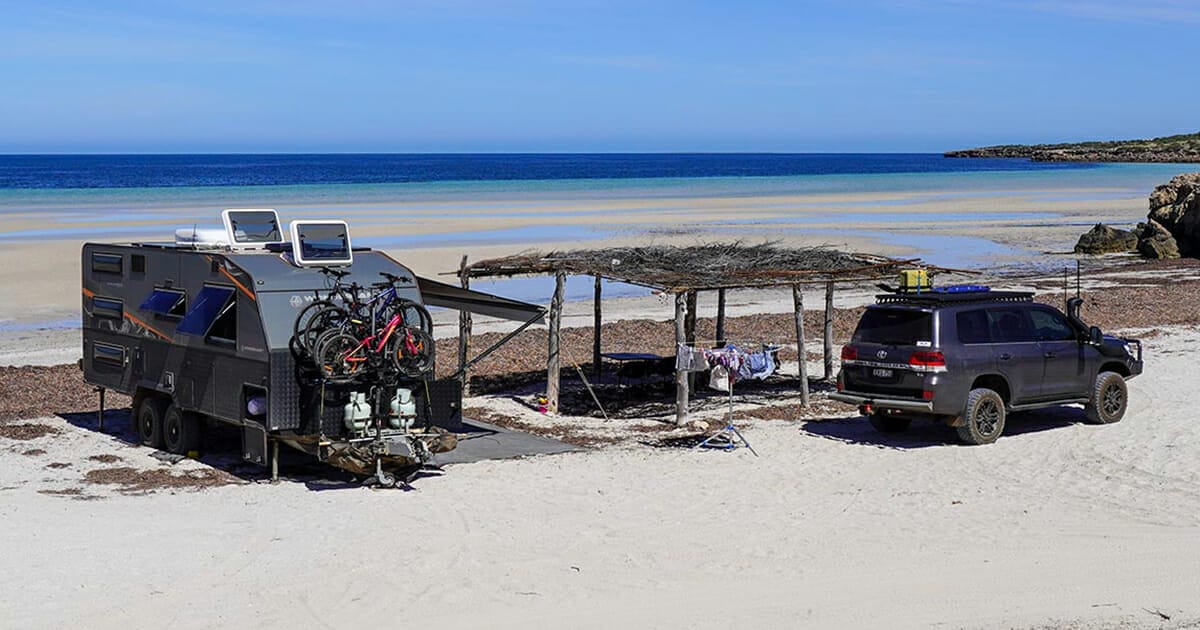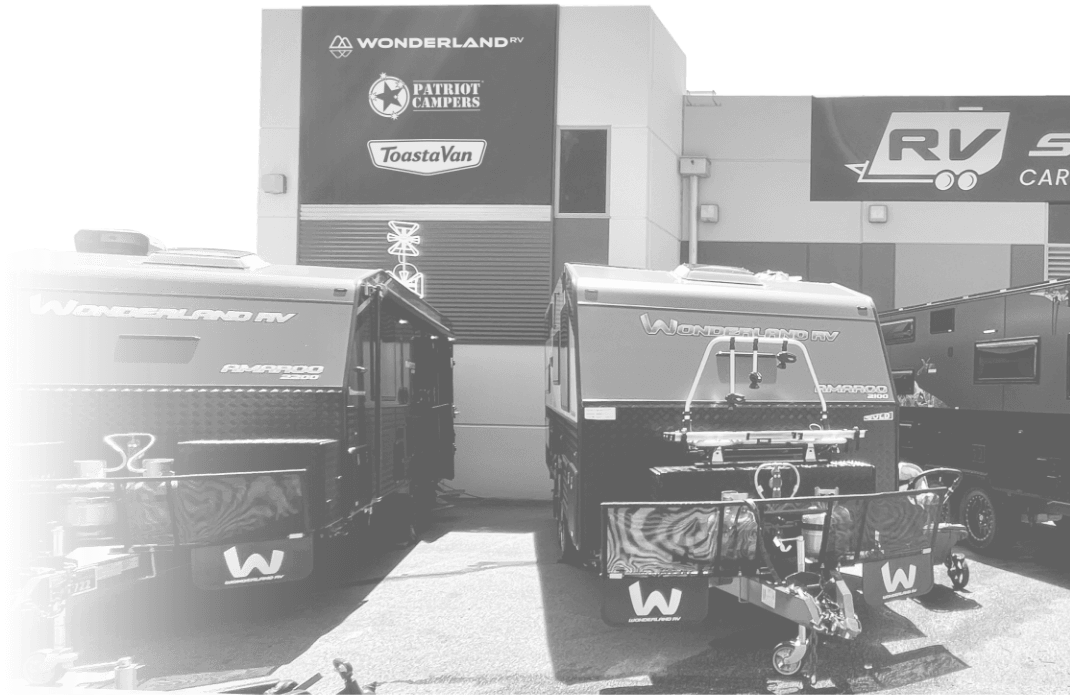
While being able to run your appliances on mains power at caravan parks is always handy, if you want to get serious and head off grid, it’s time to upgrade your system. To be completely self-sustaining when you head out, you’ll need a 12-volt camping set-up that you can rely on for many adventures to come.
Read on to discover our recommendations for setting up a killer 12v system so you can keep the beers cold, the kettle hot and the temperature in your caravan just right when you go bush.
The right battery
First things first, you’re going to need the right battery setup. There are a couple of different ones on the market but our recommendation is always an AGM deep cycle battery or lithium battery, with enough amp hours to sustain your needs, while not pushing you over your payload.
AGM or lithium battery?
An AGM deep cycle battery (Absorbent Glass Mat), is a type of lead-acid battery that uses a very fine fibreglass mat to absorb the electrolyte-rich battery acid. AGM batteries are spill-proof and able to withstand extreme temperatures, however they are extremely heavy, which will add to your overall payload. While AGM batteries aren’t the top of the line, they are a good option if you’re a beginner, or looking for a cheaper option to get started.
Lithium batteries are your other option, and by far our recommendation. While they do come at a significantly higher cost, they’re worth it—not only do they have a greater lifespan than AGM batteries, but they are also much more effective, and much lighter, allowing you to save some of your precious payload for other things.
While this is a good place to start, if you want to learn more about which battery is best for you, head to our blog that goes into detail about lithium vs AGM batteries here.
What sized battery?
The size of battery you’ll need will depend on what appliances you want to run, how often you want to run them, and how long you want to run them. Battery power is measured in amp hours (ah)—the more amp hours you have, the more power your battery will store and the longer you’ll be able to run things from it.
With this said, the more power your battery can hold, the heavier it’ll be. It’s all about figuring out how much power output you’re going to need, and comparing that with how much weight you can afford to add to your payload.
As a guide, the most common battery set up is two 100ah batteries. This will allow you to run your basic 12v appliances for about a day or two, while having the ability to recharge your spare battery from your solar panels at the same time. While this is the most basic setup, the sky’s the limit in terms of battery size if your payload can take it.
If you’re wanting to run more complex, power-hungry appliances such as air conditioning, you’ll need to look at bigger batteries such as those with 400-600ah, as well as an inverter.
Again, the best way to save on weight is by going with a lithium battery over an AGM—the weight you’ll save there will be worth the extra cost!
Solar panels

Once you’ve got your battery sorted, you need to be able to charge it. Solar panels are the easiest, most sustainable way to do this. With solar energy, you’ll experience true off grid freedom and won’t be restricted by how much fuel you can carry, or where the nearest powered camping site is. Plus, there’s no limit to how much power you can generate—the more solar panels you have, the more solar energy you’ll have going into the battery bank, and the more topped up your batteries will be!
Solar panels generate clean, renewable energy by absorbing energy from the sun and converting it into electrical energy that can be used to charge your battery. Typically the best option is to mount a solar panel on the roof of your caravan, however there are also more temporary options like flexible panels or portable panels available.
While you can install solar panels on your own, there are a lot of electrical elements that need to be set up correctly to ensure your system is completely safe. Because of this, we always recommend getting a professional to help you out. Our team at RV Solutions are experts at installing caravan solar panels, and would love to give you a hand.
Charge controller
Next up, you’ll need a charge controller to manage the flow of electricity through your system. A charge controller is a device used to regulate the flow of electricity between a solar panel, battery, and load. They are responsible for regulating the voltage and current coming from the solar panel to the battery, ensuring that the battery is not overcharged or damaged.
Choosing your charge controller
When choosing a charge controller for your 12-volt camping set-up, there are a couple of types to consider. Pulse Width Modulation (PWM) controllers are the most common and are suitable for most applications. Maximum Power Point Tracking (MPPT) controllers are more expensive but are more efficient and can handle higher power inputs.
When you’re installing a charge controller, make sure that the voltage of the controller matches the voltage of the battery. It’s also important for a controller to be installed in a well-ventilated area and kept away from moisture.
With the right charge controller and proper installation, you’ll ensure that your 12v camping set-up runs safely and efficiently. If you’re not sure which charge controller is right for you, give our friendly team a call to have a chat.
Inverter
Now you have everything you need to complete your 12v set-up… but why not take it one step further? By adding an inverter to your set-up, you’ll be able to turn your 12v system into a 240v system, which means you can stay off grid longer, and charge typical household appliances that only take 240v power.
A caravan power inverter is used to convert DC power (12v) to AC power (240v), which is the type of electricity that most common household appliances require. This means if you want to run your air conditioner, washing machine, microwave or charge your laptop while you’re off grid, you’ll need an inverter.
When installing an inverter in your caravan, it is important to ensure that it is securely mounted and all wiring is done properly. You’ll also need to make sure that the inverter is connected to the battery correctly. Again, because of all these safety-critical elements, we recommend getting a professional to help you with this part.
How to maintain your 12-volt camping set-up
Once you’ve got your system up and running, it’s important to keep an eye on it to make sure it continues to run effectively and safely. A few things to keep in mind include:
- Make sure your battery terminals are free from corrosion—if there is any rust, use a wire brush to remove it.
- Keep your solar panels clean—use a soft cloth and mild detergent to gently wipe dirt and debris from them.
- Regularly check your electrical cables for damage—if you see any exposed wires or fraying of the insulation, get the wires replaced immediately.
Time to get off the grid!
If you want to experience the freedom of heading off to a remote location, completely off grid, with no time limit on when you need to head back to civilisation, a reliable 12-volt camping set-up that is properly maintained is your answer!
Here we’ve shared a quick snapshot of our recommendations, however if you want to dive deeper into all your available power set-up options, head to our comprehensive guide on how to power a caravan off grid.
If you need a hand getting the right set up figured out, our expert team would love to help. From basic systems to completely customised solutions, there’s nothing to do with off grid caravanning that our team can’t tackle. Get in touch today to see how far off the beaten track you can go.



